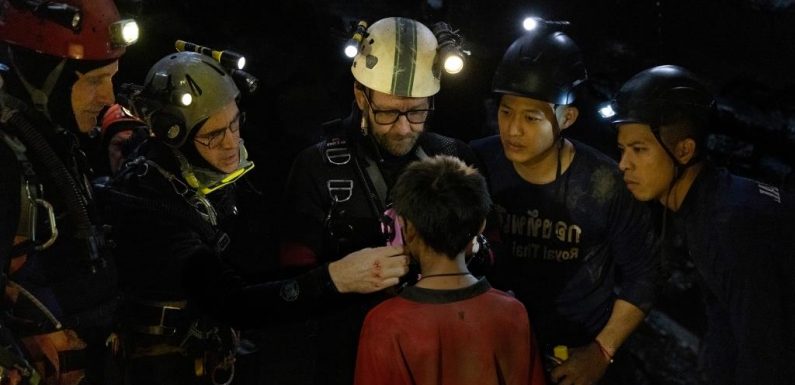
For Thirteen Lives, production designer Molly Hughes was tasked with building a set based on the Tham Luang cave system in Thailand. The challenge was creating a flooded cave system tight enough to be realistic, but large enough to fit the actors and cameras. Directed by Ron Howard, the film is based on the true story of the Thai soccer team trapped in a flooded cave, and the brave volunteer rescue divers who saved them. Although the event was highly documented, there was little documentation of the cave system, so Hughes instead focused on what would work best for the story. Early on in the production, the actors decided that they wanted to do the dives instead of stunt doubles.
Related Story
'Thirteen Lives': Read The Screenplay Behind Ron Howard's Harrowing Tale Of Survival
DEADLINE: What was the process of rebuilding that cave?
MOLLY HUGHES: It’s interesting, because we had so much research of the people, right? This is an event that was seen all over the world and there were so many photographs. There were so many journalists there from all over the world, so two years later you have access to photos upon photos upon photos, but what you don’t have is photos from inside the cave, because there was no visibility. So, there are a few photos of the entrance and a few photos, probably of an interior chamber or cavern, but that was kind of it. A lot of people didn’t realize this, but we built the entrance and the stairs as well and the base camp was built. We had so much freedom because we were starting from scratch, so I was able to orient the cave entrance so that it worked for our script and for the way scenes transpired. In a way, there was a lot of freedom in that design, which was actually pretty great.
DEADLINE: How do you create the chambers in a way that allows the cameras to film?
HUGHES: That was probably the biggest challenge. Once we found our location for the exterior, we got that engineering process underway and started drawing that. Then we moved on to this challenge of how we build these underwater sets so they can be accessible and interesting. How do we shoot in what’s supposed to be the dark? So, we started with what happens when Saman dies and what happens when Chris loses the line. We needed a moment where Chris loses the line and he gets lost. So, a tunnel full of stalactites seemed like an appropriate place for that, because it’s confusing and you can’t tell which direction you’re going. So, I designed this long tunnel, It was about 90 feet long, with an area in it where the line could get so high that he couldn’t reach it. You had to think about height and all those things, and then with an area that had enough space so cameras could be on the left or the right or above looking down.
The tunnels all had camera ports in them, or five feet of the side missing on one or two. One of them was 90 feet long, and the whole side was out so it was flat. It was called the long flat tunnel, creatively, and it was so flat that you had to go on your stomach and the child either had to be beside you or in front of you in places, and they were never below you, which was how they wanted to carry them, ideally, in the taller spaces. So, in those spaces, the camera could be on the side. Now, one thing occurred as the lead actors decided they wanted to do their own stunt work, which happened pretty soon into the film process. They were handed a camera, so then as they got more comfortable in the water, you’d have Colin holding a camera himself, swimming horizontally through, and that really helped get some great tight footage within the space. But it really was about them. They were really willing to go for it. And we had this amazing stunt team, an incredible dive team, who would just let me push boundaries.
DEADLINE: When you were first building the sets and planning everything, did you expect the actors to decide to do their own stunts?
HUGHES: No, we were prepared for doubles in those areas. But part of my design is also face masks, picking the right face masks and making sure you could see the actor’s faces through them. We ended up with these clear masks that all had clear sides on them so that the light could get through, and you could see their faces. So, we needed these moments and it was scheduled to make sure you could get moments, reactions on the faces, and then there would be doubles, which you could never see their faces. And I think the actors intuitively realized it would be so much better if it was them and there would be so much more footage to use for the audience to be right there and see who was going past.
Must Read Stories
Paul Mescal To Unleash Fresh Hell As Star In Ridley Scott’s ‘Gladiator’ Sequel
‘M3GAN’ Stalking $26M+ Debut; ‘Avatar’ Sequel Set To Cross Half-Billion Domestic
‘Way Of Water’ Slays ‘Avengers’ To Hit No. 9 On All-Time Global Chart With $1.547B
Hollywood Rallies To The Rescue, But Charity’s Financial Needs Remain “Urgent”
Read More About:
Source: Read Full Article



